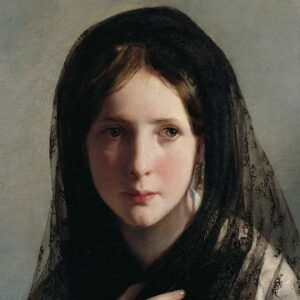Friedrich von Amerling was a painter of exceptional ability, well-known for depicting the world in a sentimental, simple, and pious manner in his portrait paintings. This nineteenth-century painter, one of the most prominent exponents of the Biedermeier Painting Movement, made a significant contribution to the development of this influential painting style. Born into nobility, this blue-blooded artist exhibited exceptional abilities in terms of contour clarity and rich coloration. In this way, his painting style was influenced by Ingres to a degree. In other words, he was one of the nineteenth century’s most eminent Austrian portrait painters. Apart from portraiture, he was an accomplished painter of historical, genre, and landscape subjects. Apart from being a painter, Amerling was also a teacher, having taught the Hungarian painter József Borsos. He primarily served the aristocracy. He is still remembered as a legendary nineteenth-century painter. To learn more about Friedrich von Amerling’s life in detail, read his biography.
Friedrich von Amerling’s Formative Years
Friedrich von Amerling was born in Vienna on 14 April 1803. Franz Amerling and Theresia Kargl were his parents. He was the son of a gold and silversmith.
He studied at Vienna’s Academy of the Arts from 1815 to 1824. He later moved to Prague, where he studied at the academy until 1826.
He lived in London from 1827 to 1828, where he came under the influence of portrait painter Sir Thomas Lawrence. He then moved to Paris, where he studied with Horace Vernet before relocating to Rome.
Career of Friedrich
Amerling was invited to come to Vienna on an official assignment while in Rome to paint a life-size portrait of Austrian Emperor Francis I. He served the Austrian court, the aristocracy, and the middle class after 1828.
He became the most sought-after and popular portrait painter in Vienna as a result of his efforts, and he held the position of Austrian court painter for approximately 15 years.
He spent a good deal of time traveling; he visited Italy in 1836 and 1838 and then the Netherlands the following year. He visited Munich in 1839, Rome in 1840–43, Spain in 1882, England in 1883, Greece in 1884, Skandinavia in 1885 toward Norway’s North Cape, and Egypt and Palestine in 1886.
Contributions of Friedric
Friedrich von Amerling created approximately 1000 works, the majority of which are portraits. His work was exhibited in Vienna in 2003.
Marriage of Friedrich
During his lifetime, Friedrich von Amerling married four times. He married Antonie Kaltenthaler in 1832 and remained married to her until her death in 1843. He married Katharina Heissler in 1844, but the marriage was short-lived and ended in divorce in 1845.
He walked down the aisle with Emilie Heinrich in 1857 and remained with her until her death in 1880. Finally, in 1881, he married Maria Nemetschke, and the couple remained married until Friedrich’s death.
Honors And Commendations
Friedrich von Amerling received numerous honors, including the Vienna Academy’s Reichel Prize (1829). As Vienna’s most admired artist, he was given several notable men of letters and musicians (such as Franz Liszt) to live with him. He acquired the Gumpendorf Castle in Vienna in 1858. In 1878, he was elevated to the dignity of Friedrich Ritter von Amerling (Friedrich, knight of Amerling). In 1879, he was awarded the Orden der Eisernen Krone.
Death of Friedrich
Friedrich died in Vienna on 14 January 1887. He was buried in the Viennese Central Cemetery and was commemorated by Johannes Benk with a memorial.
Legacy of Friedrich
The Austrian Post Office issued an extraordinary stamp on the 60th anniversary of Friedrich’s death in 1948. This Post Office later issued another Amerling stamp on 3 March 2008, this time in 2008. This stamp was part of a series commemorating the Liechtenstein Museum in Vienna and featured Liechtenstein Princess Marie Franziska.
Estimated Net Worth
The net worth of Friedrich is unknown.


